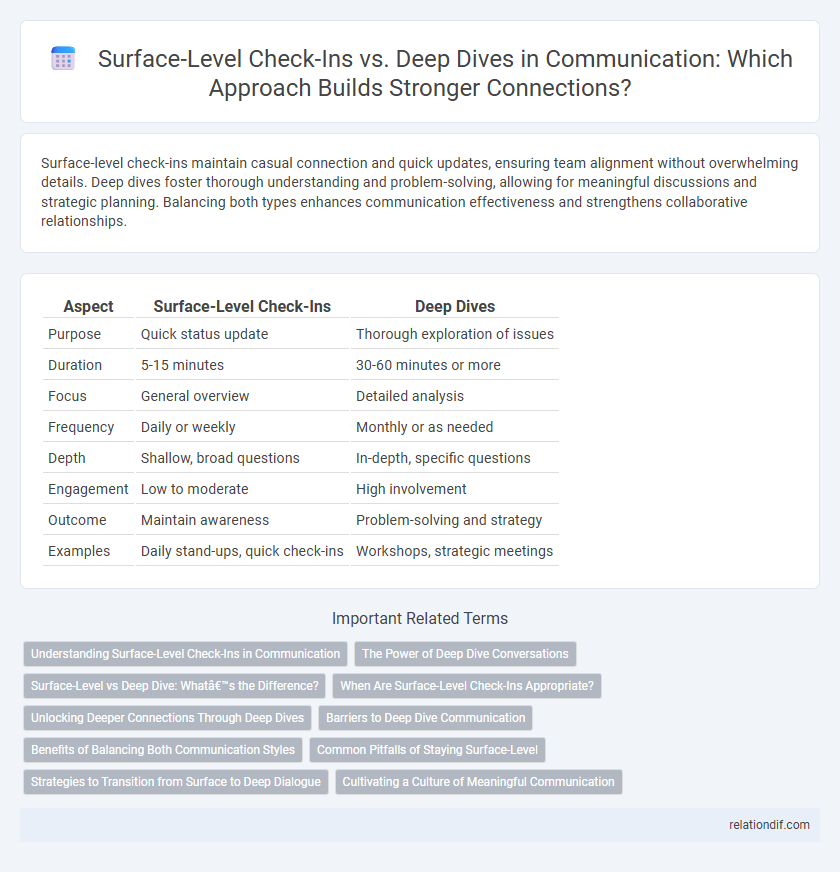Surface-level check-ins maintain casual connection and quick updates, ensuring team alignment without overwhelming details. Deep dives foster thorough understanding and problem-solving, allowing for meaningful discussions and strategic planning. Balancing both types enhances communication effectiveness and strengthens collaborative relationships.
Table of Comparison
| Aspect | Surface-Level Check-Ins | Deep Dives |
|---|---|---|
| Purpose | Quick status update | Thorough exploration of issues |
| Duration | 5-15 minutes | 30-60 minutes or more |
| Focus | General overview | Detailed analysis |
| Frequency | Daily or weekly | Monthly or as needed |
| Depth | Shallow, broad questions | In-depth, specific questions |
| Engagement | Low to moderate | High involvement |
| Outcome | Maintain awareness | Problem-solving and strategy |
| Examples | Daily stand-ups, quick check-ins | Workshops, strategic meetings |
Understanding Surface-Level Check-Ins in Communication
Surface-level check-ins in communication involve brief, casual exchanges that help maintain social connections without delving into complex emotions or issues. These interactions typically include simple questions about one's day or mood, fostering a sense of presence and attentiveness. While they do not provide comprehensive understanding, surface-level check-ins are essential for building rapport and signaling availability for deeper conversations later.
The Power of Deep Dive Conversations
Deep dive conversations foster genuine understanding by encouraging open dialogue and active listening beyond surface-level check-ins. These meaningful interactions build trust, resolve conflicts effectively, and promote emotional connection within teams or relationships. Focusing on depth in communication enhances collaboration, innovation, and long-term rapport.
Surface-Level vs Deep Dive: What’s the Difference?
Surface-level check-ins involve brief, routine updates that maintain connection without extensive detail, often used to monitor progress or address immediate needs. Deep dive conversations explore topics thoroughly, uncovering underlying issues, motivations, and complex information crucial for strategic decision-making and problem-solving. Understanding the difference enhances communication effectiveness by balancing efficiency with comprehensive insight.
When Are Surface-Level Check-Ins Appropriate?
Surface-level check-ins are appropriate during quick status updates or when teams require brief alignment without extensive detail. These interactions effectively maintain connection and ensure progress without consuming significant time or resources. They serve as efficient tools in fast-paced environments or when immediate decisions are unnecessary.
Unlocking Deeper Connections Through Deep Dives
Surface-level check-ins often skim the emotions and thoughts behind daily interactions, missing opportunities to build trust and understanding. Deep dives promote authentic communication by encouraging vulnerability, active listening, and meaningful dialogue that foster stronger relationships. Unlocking deeper connections through these intentional conversations enhances empathy, collaboration, and emotional resilience.
Barriers to Deep Dive Communication
Surface-level check-ins often fail to address underlying issues due to time constraints and fear of vulnerability, creating significant barriers to deep dive communication. Psychological safety is crucial for fostering open dialogue, yet hierarchical structures and cultural norms can inhibit honest exchanges. Overcoming these obstacles requires intentional efforts to build trust and allocate dedicated time for meaningful conversations.
Benefits of Balancing Both Communication Styles
Balancing surface-level check-ins with deep dives enhances communication by fostering quick rapport and ensuring thorough understanding. Surface-level interactions maintain connection and trust through frequent, brief exchanges, while deep dives facilitate problem-solving and meaningful collaboration with focused, in-depth discussions. Integrating both styles optimizes team dynamics, promotes transparency, and drives effective decision-making.
Common Pitfalls of Staying Surface-Level
Surface-level check-ins often lead to misunderstandings due to a lack of clarity and insufficient context, which can hinder effective communication and problem-solving. Employees may feel undervalued or disengaged when conversations avoid deeper issues, reducing trust and team cohesion. Failing to address root causes in these shallow interactions results in recurring problems and stalled progress within organizations.
Strategies to Transition from Surface to Deep Dialogue
Effective communication strategies for transitioning from surface-level check-ins to deep dives include active listening, asking open-ended questions, and fostering a safe environment that encourages vulnerability. Employing techniques such as reflective feedback and targeted follow-ups helps to uncover underlying emotions and motivations, facilitating more meaningful conversations. Consistently practicing these methods enhances trust and promotes authentic dialogue, leading to stronger interpersonal connections.
Cultivating a Culture of Meaningful Communication
Surface-level check-ins foster routine updates but often lack emotional connection, limiting genuine understanding. Deep dives encourage openness, trust, and nuanced conversations, enhancing team cohesion and problem-solving. Cultivating a culture of meaningful communication requires prioritizing these in-depth interactions to build empathy and alignment.
surface-level check-ins vs deep dives Infographic

 relationdif.com
relationdif.com